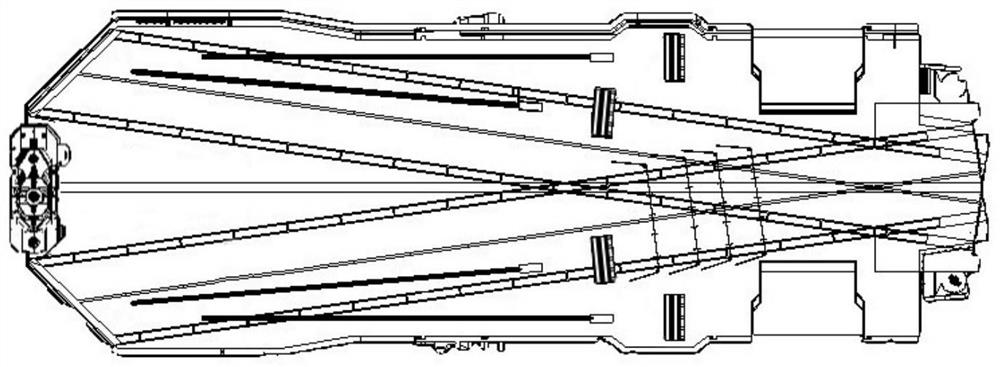Deck layout structure of aircraft carrier
A technology of aircraft carrier and layout structure, which is applied in the direction of aircraft carrier, special-purpose ships, aircraft parts, etc., and can solve problems such as the small range of movement of the aircraft in the dispatching area, the inability of the MiG 29k to land, and the large impact of wind on the rear deck to achieve landing failure. Enhanced fault tolerance rate, more variety options, and reduced scheduling difficulty
- Summary
- Abstract
- Description
- Claims
- Application Information
AI Technical Summary
Problems solved by technology
Method used
Image
Examples
Embodiment 1
[0025] Such as Figure 1-2 As shown, the deck layout structure of the aircraft carrier in this embodiment is used to optimize the layout design of the deck structure of the aircraft carrier, thereby optimizing the activities such as take-off and landing of the carrier-based aircraft, and improving the combat capability of the aircraft carrier.
[0026] Specifically, the deck layout structure includes the layout design of the deck and the layout design of the ship island 4 on the deck, wherein the deck is symmetrically arranged with a left bevel deck 2 and a right bevel deck 3, preferably arranged along the center line of the deck, the ship The body is more balanced and stable. The left bevel deck 2 and the right bevel deck 3 respectively have a through area through the tail of the deck; Out of the first landing runway center line 22, the right bevel deck 3 is divided into a second landing runway 31 along the inclination angle of the right bevel deck 3, and the second landing ...
Embodiment 2
[0035] The difference between the deck layout structure of the aircraft carrier of the present embodiment and the first embodiment is:
[0036] Such as image 3 As shown, the deck layout structure of the aircraft carrier of the present embodiment cancels the layout of the front deck, and the ship island is arranged horizontally at the front end of the deck, and the horizontal direction refers to the horizontal direction along the hull, with up to 4-6 runways, of which 2-4 take-off runways, 2 The combat strength is greater than that of existing warships, and the overall length has become smaller, and the tonnage has decreased. The tonnage is between the aircraft carrier and the amphibious assault ship. 1, and the shortened hull and components can be used in a wide range with amphibious assault ships to form a family of ships, further reducing the cost; further, the increase in production driven by N+1 can evenly share the research and development costs, saving more precious ti...
Embodiment 3
[0039] The differences between the deck layout structure of the aircraft carrier of the present embodiment and the second embodiment are:
[0040] Such as Figure 4 As shown, the deck layout structure of the aircraft carrier of the present embodiment, the ship island is vertically arranged in the middle part of the front end of the deck. Preferably, when the ship island is arranged, its distance from the centerline of the near-end landing runway is greater than or equal to 30 meters. The overall size becomes smaller and the cost is lowered. At the same time, the area blocked by the ship island when the aircraft takes off and lands becomes smaller, and the aircraft has a wider field of vision when taking off and landing, which is good for the pilot's psychology, reduces the error rate of operation, and enhances the stability of the aircraft carrier in combat. Furthermore, aircraft parking spaces or elevators are arranged between the ship island and the angle between the left a...
PUM
 Login to View More
Login to View More Abstract
Description
Claims
Application Information
 Login to View More
Login to View More - R&D Engineer
- R&D Manager
- IP Professional
- Industry Leading Data Capabilities
- Powerful AI technology
- Patent DNA Extraction
Browse by: Latest US Patents, China's latest patents, Technical Efficacy Thesaurus, Application Domain, Technology Topic, Popular Technical Reports.
© 2024 PatSnap. All rights reserved.Legal|Privacy policy|Modern Slavery Act Transparency Statement|Sitemap|About US| Contact US: help@patsnap.com










